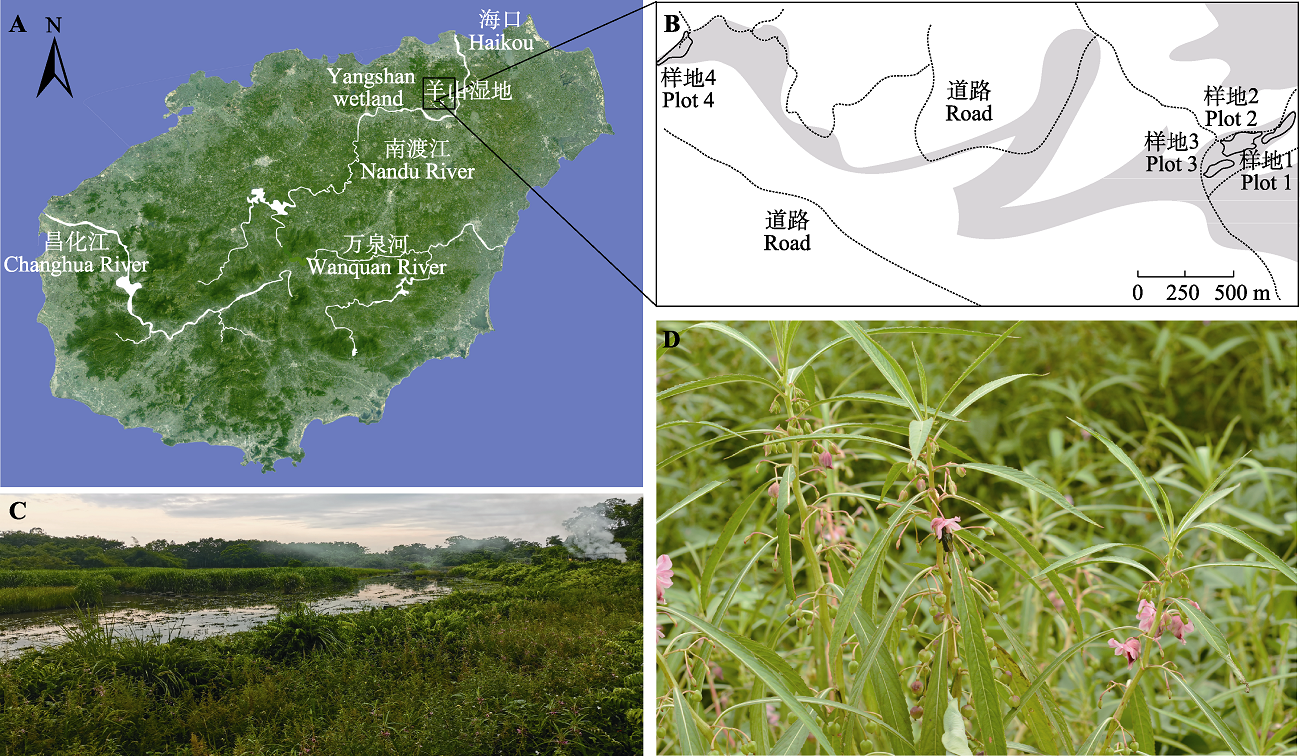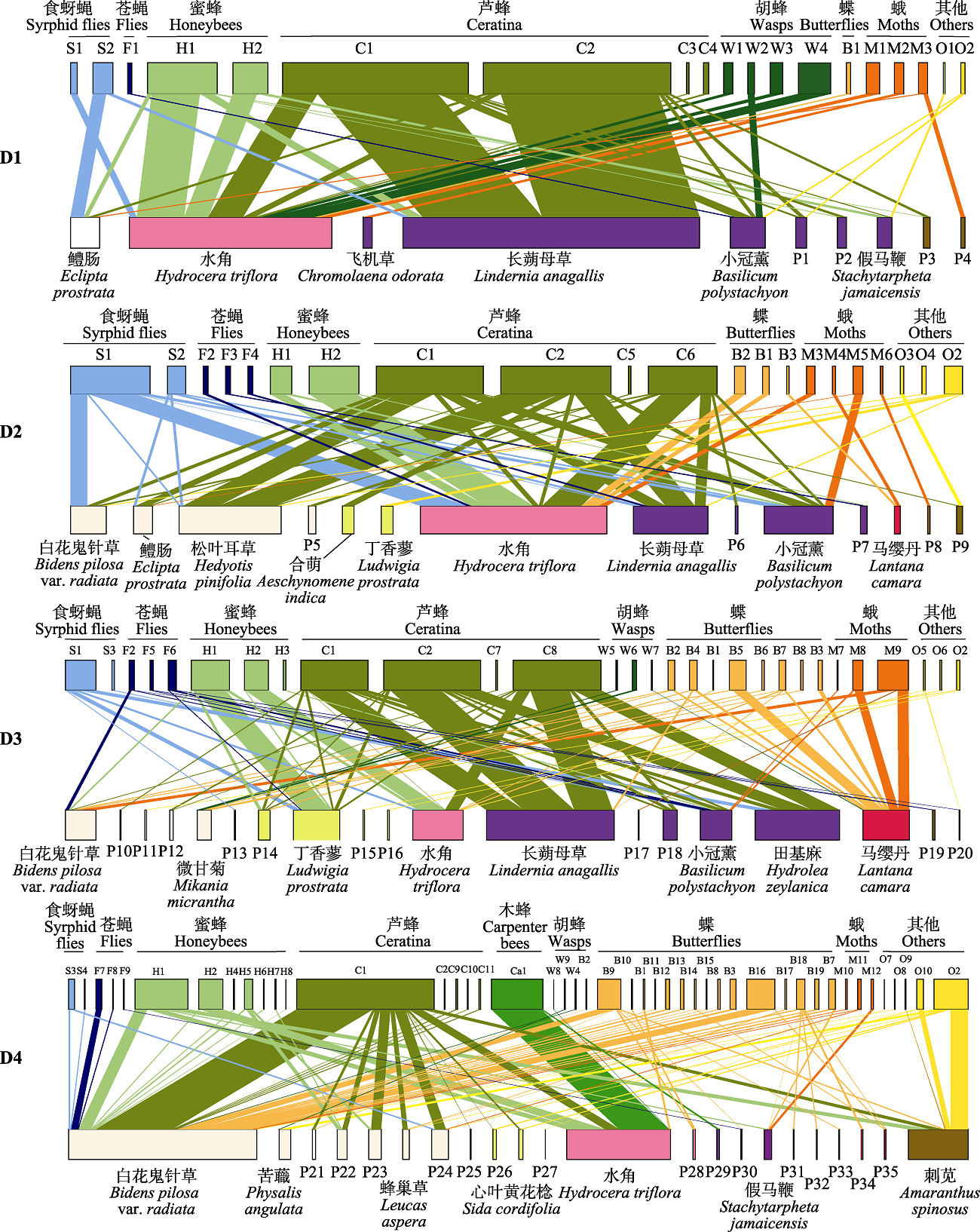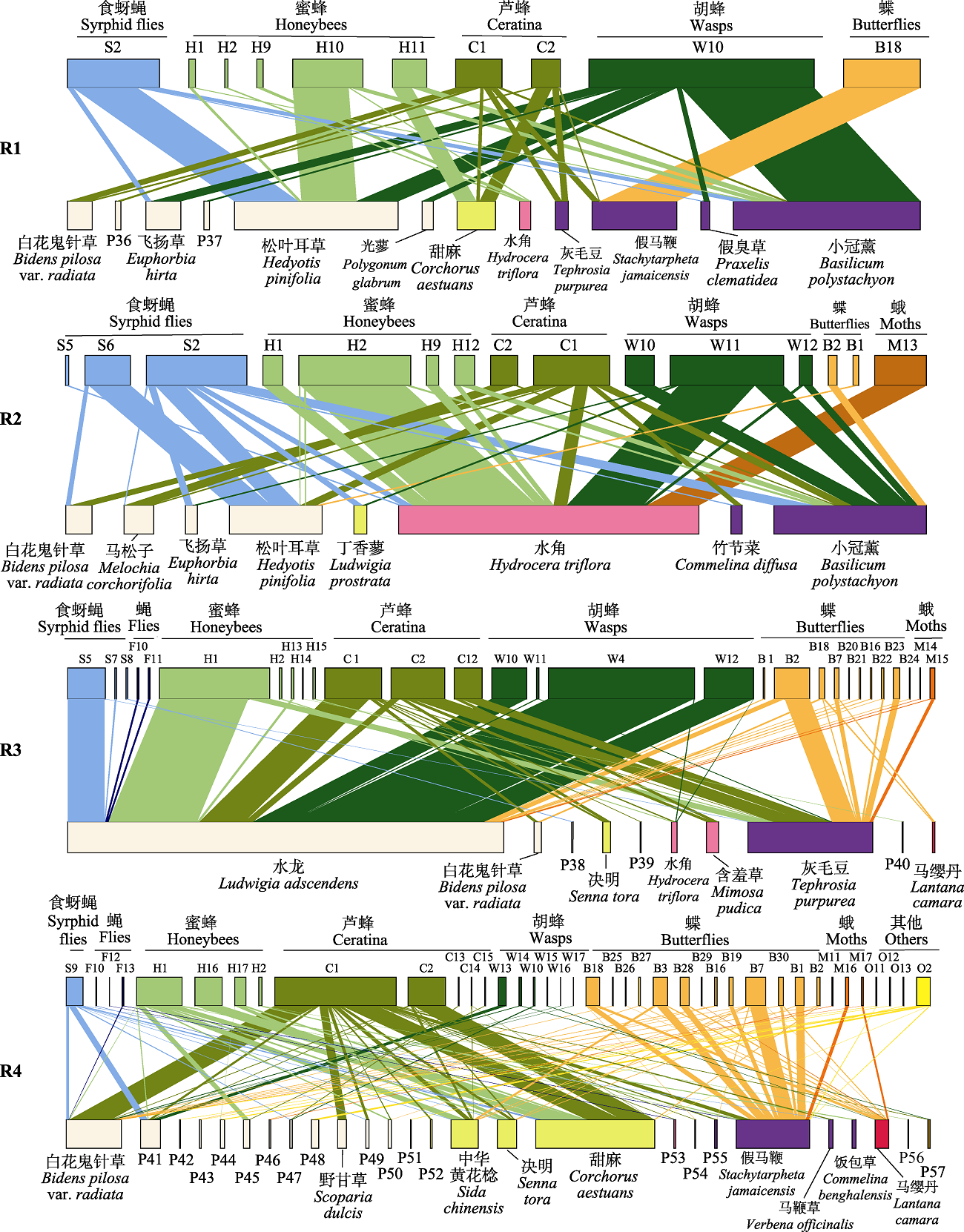

Chin J Plant Ecol ›› 2022, Vol. 46 ›› Issue (7): 775-784.DOI: 10.17521/cjpe.2021.0281
• Research Articles • Previous Articles Next Articles
ZENG Kai-Na1,2, SUN Hao-Ran1,2, SHEN Yi-Chun1, REN Ming-Xun1,2,*( )
)
Received:2021-08-02
Accepted:2022-01-14
Online:2022-07-20
Published:2022-06-09
Contact:
REN Ming-Xun
Supported by:ZENG Kai-Na, SUN Hao-Ran, SHEN Yi-Chun, REN Ming-Xun. Pollination network and seasonal dynamics of Yangshan Wetland in Hainan Island, China[J]. Chin J Plant Ecol, 2022, 46(7): 775-784.
Add to citation manager EndNote|Ris|BibTeX
URL: https://www.plant-ecology.com/EN/10.17521/cjpe.2021.0281

Fig. 1 Study sites and landscapes of Yangshan Wetland in Hainan Island. A, Location of Yangshan wetland in Hainan Island. B, Four experimental plots. C, Landscape of Plot 4 in dry season. D, The most common emergent macrophytes plants Hydrocera triflora (a carpenter bee is visiting a flower on the middle plant).
| 传粉网络 Pollination network | 开花植物 Plants in blooming (P) | 传粉者Pollinator (A) | 网络尺寸 Network size (P × A) | 连接数量 Number of interaction (I) | 连接度 Connectance (I/(P × A)) | 嵌套度 Weighted nestedness | 网络特化 程度 H′2 |
|---|---|---|---|---|---|---|---|
| 旱季样地1 D1 | 10 | 19 | 190 | 37 | 0.19 | 5.73 | -0.33 |
| 旱季样地2 D2 | 14 | 21 | 294 | 49 | 0.17 | 4.78 | -0.28 |
| 旱季样地3 D3 | 19 | 29 | 551 | 73 | 0.13 | 5.70 | -0.22 |
| 旱季样地4 D4 | 22 | 45 | 990 | 84 | 0.08 | 11.71 | -0.37 |
| 旱季合计 Dry season total | 49 | 82 | 4 018 | 244 | 0.06 | 0.65 | 0.45 |
| 雨季样地1 R1 | 12 | 10 | 120 | 30 | 0.25 | 3.62 | -0.12 |
| 雨季样地2 R2 | 8 | 15 | 120 | 35 | 0.29 | 5.89 | -0.15 |
| 雨季样地3 R3 | 10 | 29 | 290 | 49 | 0.17 | 6.99 | -0.32 |
| 雨季样地4 R4 | 26 | 39 | 1 014 | 103 | 0.10 | 8.96 | -0.33 |
| 雨季合计 Rainy season total | 44 | 66 | 2 904 | 235 | 0.08 | 0.62 | 0.52 |
Table 1 Parameters of pollination network in different seasons of Yangshan Wetland in Hainan Island
| 传粉网络 Pollination network | 开花植物 Plants in blooming (P) | 传粉者Pollinator (A) | 网络尺寸 Network size (P × A) | 连接数量 Number of interaction (I) | 连接度 Connectance (I/(P × A)) | 嵌套度 Weighted nestedness | 网络特化 程度 H′2 |
|---|---|---|---|---|---|---|---|
| 旱季样地1 D1 | 10 | 19 | 190 | 37 | 0.19 | 5.73 | -0.33 |
| 旱季样地2 D2 | 14 | 21 | 294 | 49 | 0.17 | 4.78 | -0.28 |
| 旱季样地3 D3 | 19 | 29 | 551 | 73 | 0.13 | 5.70 | -0.22 |
| 旱季样地4 D4 | 22 | 45 | 990 | 84 | 0.08 | 11.71 | -0.37 |
| 旱季合计 Dry season total | 49 | 82 | 4 018 | 244 | 0.06 | 0.65 | 0.45 |
| 雨季样地1 R1 | 12 | 10 | 120 | 30 | 0.25 | 3.62 | -0.12 |
| 雨季样地2 R2 | 8 | 15 | 120 | 35 | 0.29 | 5.89 | -0.15 |
| 雨季样地3 R3 | 10 | 29 | 290 | 49 | 0.17 | 6.99 | -0.32 |
| 雨季样地4 R4 | 26 | 39 | 1 014 | 103 | 0.10 | 8.96 | -0.33 |
| 雨季合计 Rainy season total | 44 | 66 | 2 904 | 235 | 0.08 | 0.62 | 0.52 |

Fig. 2 Pollination network in dry season of four plots (D1-D4) of Yangshan Wetland in Hainan Island. In each pollination network, the top and bottom represent pollinators and plants, respectively. The size indicates relative abundancy and the width of the link represents the correlation strength. P1-P35 are plants (Supplement VI) and codes under each pollinator functional group represent different species.

Fig. 3 Pollination network in rainy season of four plots (R1-R4) of Yangshan Wetland in Hainan Island. In each pollination network, the top and bottom represent pollinators and plants, respectively. The size indicates relative abundancy and the width of the link represents the correlation strength. P1-P35 are plants (Supplement VI) and codes under each pollinator functional group represent the different species.
| 植物 Plant | 传粉网络 Pollination network | 传粉者种类 Pollinator species | 物种强度 Species strength | 专一性 Standardized Kullback- Leibler distance (d′) |
|---|---|---|---|---|
| 白花鬼针草 Bidens pilosa var. radiata | 旱季 DZ | 40 | 12.484 0 | 0.551 0 |
| 雨季 RZ | 18 | 3.852 7 | 0.671 4 | |
| 水角 Hydrocera triflora | 旱季 DZ | 20 | 26.212 4 | 0.462 4 |
| 雨季 RZ | 12 | 6.977 5 | 0.455 6 | |
| 假马鞭 Stachytarpheta jamaicensis | 旱季 DZ | 7 | 2.266 9 | 0.477 4 |
| 雨季 RZ | 15 | 7.707 9 | 0.696 1 | |
| 马缨丹 Lantana camara | 旱季 DZ | 12 | 5.657 1 | 0.773 4 |
| 雨季 RZ | 10 | 5.248 1 | 0.646 1 | |
| 小冠薰 Basilicum polystachyon | 旱季 DZ | 17 | 7.241 9 | 0.317 5 |
| 雨季 RZ | 12 | 2.439 9 | 0.508 6 |
Table 2 Species level parameters of common plants of the Yangshan Wetland in Hainan Island
| 植物 Plant | 传粉网络 Pollination network | 传粉者种类 Pollinator species | 物种强度 Species strength | 专一性 Standardized Kullback- Leibler distance (d′) |
|---|---|---|---|---|
| 白花鬼针草 Bidens pilosa var. radiata | 旱季 DZ | 40 | 12.484 0 | 0.551 0 |
| 雨季 RZ | 18 | 3.852 7 | 0.671 4 | |
| 水角 Hydrocera triflora | 旱季 DZ | 20 | 26.212 4 | 0.462 4 |
| 雨季 RZ | 12 | 6.977 5 | 0.455 6 | |
| 假马鞭 Stachytarpheta jamaicensis | 旱季 DZ | 7 | 2.266 9 | 0.477 4 |
| 雨季 RZ | 15 | 7.707 9 | 0.696 1 | |
| 马缨丹 Lantana camara | 旱季 DZ | 12 | 5.657 1 | 0.773 4 |
| 雨季 RZ | 10 | 5.248 1 | 0.646 1 | |
| 小冠薰 Basilicum polystachyon | 旱季 DZ | 17 | 7.241 9 | 0.317 5 |
| 雨季 RZ | 12 | 2.439 9 | 0.508 6 |
| [1] |
Aizen MA, Morales CL, Morales JM (2008). Invasive mutualists erode native pollination webs. PLOS Biology, 6, e31. DOI: 10.1371/journal.pbio.0060031.
DOI URL |
| [2] |
Asada T (2002). Vegetation gradients in relation to temporal fluctuation of environmental factors in Bekanbeushi peatland, Hokkaido, Japan. Ecological Research, 17, 505-518.
DOI URL |
| [3] |
Bascompte J, Jordano P (2007). Plant-animal mutualistic networks: the architecture of biodiversity. Annual Review of Ecology, Evolution, and Systematics, 38, 567-593.
DOI URL |
| [4] |
Bascompte J, Jordano P, Melián CJ, Olesen JM (2003). The nested assembly of plant-animal mutualistic networks. Proceedings of the National Academy of Sciences of the United States of America, 100, 9383-9387.
DOI PMID |
| [5] |
Bascompte J, Jordano P, Olesen JM (2006). Asymmetric coevolutionary networks facilitate biodiversity maintenance. Science, 312, 431-433.
PMID |
| [6] |
Bastolla U, Fortuna MA, Pascual-García A, Ferrera A, Luque B, Bascompte J (2009). The architecture of mutualistic networks minimizes competition and increases biodiversity. Nature, 458, 1018-1020.
DOI URL |
| [7] |
Blüthgen N, Menzel F, Blüthgen N (2006). Measuring specialization in species interaction networks. BMC Ecology, 6, 9. DOI: 10.1186/1472-6785-6-9.
DOI PMID |
| [8] |
Blüthgen N, Menzel F, Hovestadt T, Fiala B, Blüthgen N (2007). Specialization, constraints, and conflicting interests in mutualistic networks. Current Biology, 17, 341-346.
PMID |
| [9] | CaraDonna PJ, Burkle LA, Schwarz B, Resasco J, Knight TM, Benadi G, Blüthgen N, Dormann CF, Fang Q, Fründ J, Gauzens B, Kaiser-Bunbury CN, Winfree R, Vázquez DP (2021). Seeing through the static: the temporal dimension of plant-animal mutualistic interactions. Ecology Letters, 24, 149-161. |
| [10] |
Casanova M, Brock M (2000). How do depth, duration and frequency of flooding influence the establishment of wetland plant communities? Plant Ecology, 147, 237-250.
DOI URL |
| [11] |
Castro-Urgal R, Traveset A (2014). Differences in flower visitation networks between an oceanic and a continental island. Botanical Journal of the Linnean Society, 174, 478- 488.
DOI URL |
| [12] |
Cuartas-Hernández S, Medel R (2015). Topology of plant-flower-visitor networks in a tropical mountain forest: insights on the role of altitudinal and temporal variation. PLOS ONE, 10, e0141804. DOI: 10.1371/journal.pone.0141804.
DOI URL |
| [13] |
Dormann CF, Fründ J, Schaefer HM (2017). Identifying causes of patterns in ecological networks: opportunities and limitations. Annual Review of Ecology, Evolution, and Systematics, 48, 559-584.
DOI URL |
| [14] |
Dupont YL, Padrón B, Olesen JM, Petanidou T (2009). Spatio- temporal variation in the structure of pollination networks. Oikos, 118, 1261-1269.
DOI URL |
| [15] |
Fang Q, Huang SQ (2012). Progress in pollination networks: network structure and dynamics. Biodiversity Science, 20, 300-307.
DOI URL |
|
[方强, 黄双全 (2012). 传粉网络的研究进展: 网络的结构和动态. 生物多样性, 20, 300-307.]
DOI |
|
| [16] |
Fang Q, Huang SQ (2012). Relative stability of core groups in pollination networks in a biodiversity hotspot over four years. PLOS ONE, 7, e32663. DOI: 10.1371/journal.pone.0032663.
DOI URL |
| [17] |
Gómez JM, Perfectti F, Jordano P (2011). The functional consequences of mutualistic network architecture. PLOS ONE, 6, e16143. DOI: 10.1371/journal.pone.0016143.
DOI URL |
| [18] |
Haapalehto TO, Vasander H, Jauhiainen S, Tahvanainen T, Kotiaho JS (2011). The effects of peatland restoration on water-table depth, elemental concentrations, and vegetation: 10 years of changes. Restoration Ecology, 19, 587-598.
DOI URL |
| [19] |
Jones KN, Klemetti SM (2012). Managing marginal populations of the rare wetland plant Trollius laxus Salisbury (spreading globeflower): consideration of light levels, herbivory, and pollination. Northeastern Naturalist, 19, 267-278.
DOI URL |
| [20] | Kaiser-Bunbury CN, Muff S, Memmott J, Müller CB, Caflisch A (2010). The robustness of pollination networks to the loss of species and interactions: a quantitative approach incorporating pollinator behaviour. Ecology Letters, 13, 442-452. |
| [21] |
Lundgren R, Olesen JM (2005). The dense and highly connected world of greenland's plants and their pollinators. Arctic, Antarctic, and Alpine Research, 37, 514-520.
DOI URL |
| [22] |
Olesen JM, Bascompte J, Elberling H, Jordano P (2008). Temporal dynamics in a pollination network. Ecology, 89, 1573-1582.
PMID |
| [23] | Olesen JM, Jordano P (2002). Geographic patterns in plant- pollinator mutualistic networks. Ecology, 83, 2416-2424. |
| [24] |
Pawar S (2014). Why are plant-pollinator networks nested? Science, 345, 383. DOI: 10.1126/science.1256466.
DOI URL |
| [25] |
Ponisio LC, Gaiarsa MP, Kremen C (2017). Opportunistic attachment assembles plant-pollinator networks. Ecology Letters, 20, 1261-1272.
DOI PMID |
| [26] |
Saavedra S, Rohr RP, Fortuna MA, Selva N, Bascompte J (2016). Seasonal species interactions minimize the impact of species turnover on the likelihood of community persistence. Ecology, 97, 865-873.
PMID |
| [27] |
Santamaría S, Galeano J, Pastor JM, Méndez M (2016). Removing interactions, rather than species, casts doubt on the high robustness of pollination networks. Oikos, 125, 526-534.
DOI URL |
| [28] |
Schleuning M, Fründ J, Klein AM, Abrahamczyk S, Alarcón R, Albrecht M, Andersson GKS, Bazarian S, Böhning-Gaese K, Bommarco R, Dalsgaard B, Dehling DM, Gotlieb A, Hagen M, Hickler T, et al. (2012). Specialization of mutualistic interaction networks decreases toward tropical latitudes. Current Biology, 22, 1925-1931.
DOI PMID |
| [29] |
Souza CS, Maruyama PK, Aoki C, Sigrist MR, Raizer J, Gross CL, de Araujo AC (2018). Temporal variation in plant- pollinator networks from seasonal tropical environments: higher specialization when resources are scarce. Journal of Ecology, 106, 2409-2420.
DOI URL |
| [30] | State Forestry Administration of the People's Republic of China (2015). China Wetlands Resources Hainan Volume. China Forestry Publishing House, Beijing. |
| [中华人民共和国国家林业局 (2015). 中国湿地资源: 海南卷. 中国林业出版社, 北京.] | |
| [31] |
Tu YL, Wang LP, Wang XL, Wang LL, Duan YW (2019). Status of invasive plants on local pollination networks: a case study of Tagetes minuta in Tibet based on pollen grains from pollinators. Biodiversity Science, 27, 306-313.
DOI URL |
|
[土艳丽, 王力平, 王喜龙, 王林林, 段元文 (2019). 利用昆虫携带的花粉初探西藏入侵植物印加孔雀草在当地传粉网络中的地位. 生物多样性, 27, 306-313.]
DOI |
|
| [32] | Vasander H (1982). Plant biomass and production in virgin, drained and fertilized sites in a raised bog in southern Finland. Annales Botanici Fennici, 19, 103-125. |
| [33] |
Vázquez DP, Simberloff D (2002). Ecological specialization and susceptibility to disturbance: conjectures and refutations. The American Naturalist, 159, 606-623.
DOI PMID |
| [1] | NIU Yi-Di, CAI Ti-Jiu. Changes in species diversity and influencing factors in secondary forest succession in northern Da Hinggan Mountains [J]. Chin J Plant Ecol, 2024, 48(3): 349-363. |
| [2] | LI Na, TANG Shi-Ming, GUO Jian-Ying, TIAN Ru, WANG Shan, HU Bing, LUO Yong-Hong, XU Zhu-Wen. Meta-analysis of effects of grazing on plant community properties in Nei Mongol grassland [J]. Chin J Plant Ecol, 2023, 47(9): 1256-1269. |
| [3] | YANG Xin, REN Ming-Xun. Species distribution pattern and formation mechanism of mangrove plants around the South China Sea [J]. Chin J Plant Ecol, 2023, 47(8): 1105-1115. |
| [4] | YU Xiao, JI Ruo-Xuan, REN Tian-Meng, XIA Xin-Li, YIN Wei-Lun, LIU Chao. Distribution, characteristics and classification of Caryopteris mongholica communities in northern China [J]. Chin J Plant Ecol, 2023, 47(8): 1182-1192. |
| [5] | FENG Shan-Shan, HUANG Chun-Hui, TANG Meng-Yun, JIANG Wei-Xin, BAI Tian-Dao. Geographical variation of needles phenotypic and anatomic traits between populations of Pinus yunnanensis var. tenuifolia and its environmental interpretation [J]. Chin J Plant Ecol, 2023, 47(8): 1116-1130. |
| [6] | HU Zhao-Yi, CHEN Tian-Song, ZHAO Li, XU Pei-Xuan, WU Zheng-Jiang, DONG Li-Qin, ZHANG Kun. Effect of water level drop on nitrogen and phosphorus reabsorption of Carex muliensis in a herb swamp in Zoigê wetland, China [J]. Chin J Plant Ecol, 2023, 47(6): 847-855. |
| [7] | XU Gan-Jun, WU Sheng-Yi, LI Wei, ZHAO Xin-Sheng, NIE Lei-Chao, TANG Xi-Ying, ZHAI Xia-Jie. Estimation of carbon storage in Shaanxi Yellow River Wetland Provincial Nature Reserve [J]. Chin J Plant Ecol, 2023, 47(4): 469-478. |
| [8] | ZHU Hua, TAN Yun-Hong. Community characteristics, research states and problems of tropical rain forests in China [J]. Chin J Plant Ecol, 2023, 47(4): 447-468. |
| [9] | WANG Wen-Wei, HAN Wei-Peng, LIU Wen-Wen. Short-term response of leaf functional traits of the invasive plant Spartina alterniflora to a tidal gradient in coastal wetlands [J]. Chin J Plant Ecol, 2023, 47(2): 216-226. |
| [10] | YANG Ling, LIANG Si-Qi, PAN Jia-Ming, WEI Jin-Xin, DING Tao, JIANG Ri-Hong, SHAO Yi-Zhen, ZHANG Xian-Chun, LIU Yong-Bo, XIANG Qiao-Ping. Species delimitation and genetic conservation of the endangered firs Abies beshanzuensis and A. ziyuanensis [J]. Chin J Plant Ecol, 2023, 47(12): 1629-1645. |
| [11] | LI Jie, HAO Min-Hui, FAN Chun-Yu, ZHANG Chun-Yu, ZHAO Xiu-Hai. Effect of tree species and functional diversity on ecosystem multifunctionality in temperate forests of northeast China [J]. Chin J Plant Ecol, 2023, 47(11): 1507-1522. |
| [12] | YANG Yuan-He, ZHANG Dian-Ye, WEI Bin, LIU Yang, FENG Xue-Hui, MAO Chao, XU Wei-Jie, HE Mei, WANG Lu, ZHENG Zhi-Hu, WANG Yuan-Yuan, CHEN Lei-Yi, PENG Yun-Feng. Nonlinear responses of community diversity, carbon and nitrogen cycles of grassland ecosystems to external nitrogen input [J]. Chin J Plant Ecol, 2023, 47(1): 1-24. |
| [13] | WANG Jun-Qiang, LIU Bin, CHANG Feng, MA Zi-Jing, FAN Jia-Hui, HE Xiang-Ju, YOU Si-Xue, Aerziguli ABUDUREXITI, YANG Ying-Ke, SHEN Xin-Yan. Plant functional traits and ecological stoichiometric characteristics under water-salt gradient in the lakeshore zone of Bosten Lake [J]. Chin J Plant Ecol, 2022, 46(8): 961-970. |
| [14] | DONG Liu-Wen, REN Zheng-Wei, ZHANG Rui, XIE Chen-Di, ZHOU Xiao-Long. Functional diversity rather than species diversity can explain community biomass variation following short-term nitrogen addition in an alpine grassland [J]. Chin J Plant Ecol, 2022, 46(8): 871-881. |
| [15] | ZHANG Jin-Feng, GE Shu-Sen, LIANG Jin-Hua, LI Jun-Qing. Population age structure and dynamics of Pinus koraiensis in a broadleaved Korean pine forest in Changbai Mountain, China [J]. Chin J Plant Ecol, 2022, 46(6): 667-677. |
| Viewed | ||||||
|
Full text |
|
|||||
|
Abstract |
|
|||||
Copyright © 2022 Chinese Journal of Plant Ecology
Tel: 010-62836134, 62836138, E-mail: apes@ibcas.ac.cn, cjpe@ibcas.ac.cn